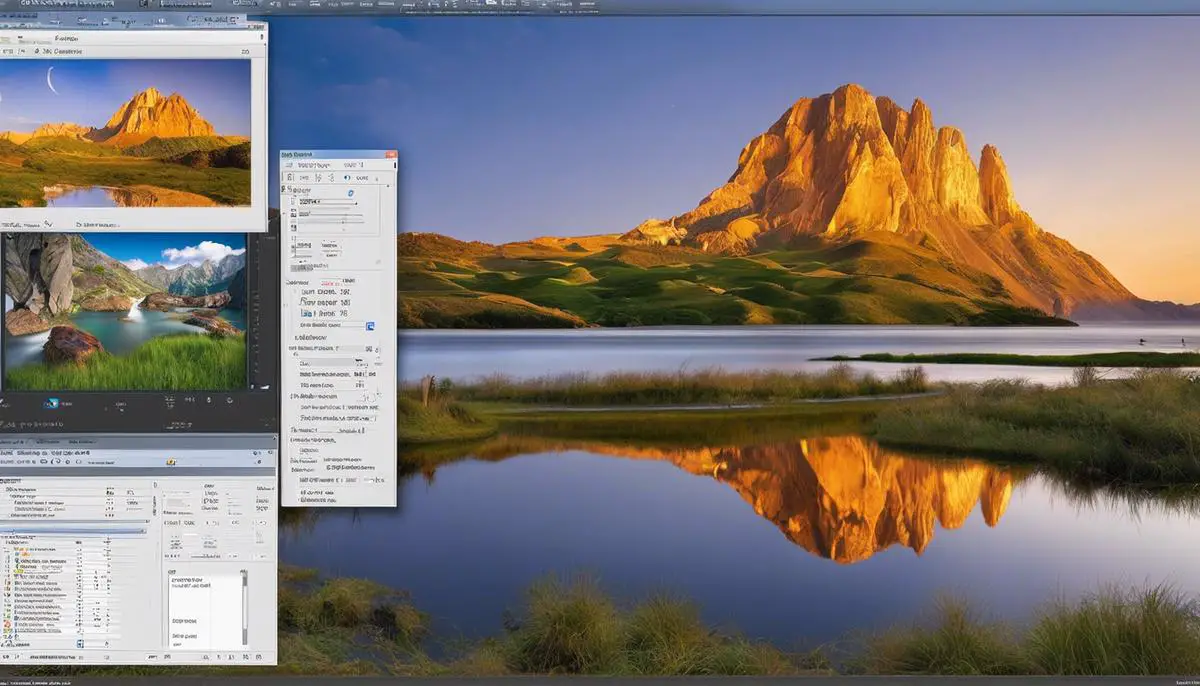In a digital world that increasingly communicates through visual media, the ability to proficiently resize images while preserving their quality is an indispensable skill for professionals across various fields. Whether you’re a graphic designer, a photographer, or simply looking to enhance your digital portfolio, understanding the nuances of image resolution is crucial. Delving into the depths of pixels and dimensions provides the fundamental knowledge required to manipulate image size without compromising clarity. Alongside this, learning to navigate through the rich features of industry-standard software such as Adobe Photoshop and GIMP, as well as the conveniences offered by an array of online tools, enables one to achieve optimal results in image scaling endeavors. The intricacies of maintaining the aspect ratio further complements this expertise, ensuring that each resized image retains its original proportional integrity. This exploration not only imbues professionals with technical mastery but also enhances the visual impact of their work in the ever-evolving digital landscape.
Contents
Understanding Image Resolution
Unpacking the Pixel Puzzle: Why Image Resolution Reigns Supreme in Resizing
In today’s visual-centric digital landscape, image resolution is not a trivial detail—it’s the backbone of digital imagery. If you’ve ever attempted to resize an image only to be met with a blurry, pixelated mess, you’ve encountered the unforgiving reality of insufficient resolution. So why does image resolution take center stage when it comes to resizing? Let’s dive into the nitty-gritty of pixels and clarity.
Understanding Image Resolution
Think of an image as a mosaic, with each tile representing a pixel. The term ‘resolution’ refers to the density of these pixels within an image, measured in PPI (pixels per inch) or DPI (dots per inch). High-resolution images pack a greater number of pixels into every inch, like an intricately detailed mosaic.
Clarity is King
When scaling images up, the resize process stretches existing pixels over a larger area. Without a sufficient pixel count to start with, you can’t maintain clarity. This is why high-resolution images are indispensable—they contain enough pixel data to stay sharp and clear, even as their dimensions grow.
The Quality Quotient
Resizing images is not simply about making them larger or smaller. It’s about preserving quality. Say you’re working on a billboard design. Upscaling a low-res file will leave viewers squinting at a blurry image. Conversely, when shrinking an image, high-resolution files provide the flexibility to reduce size without losing important details.
Print Vs. Digital: A Resolution Rift
Resolution requirements differ vastly between print and digital platforms. For print, detailed, high-resolution images are paramount to avoid a grainy appearance. Digital platforms are more lenient since screens typically showcase fewer pixels per inch. However, upsizing for digital displays can still result in quality loss if the original resolution is too low.
Automation and Analysis
Embrace automation for efficiency, but be analytical about image resolution. Software solutions exist to streamline the resizing process, but automated tools can’t compensate for a lack of pixel density. Invest time in selecting the right resolution from the get-go, and resizing becomes a straightforward, quality-assured task.
The Takeaway
To resize without regret, prioritize high-resolution images. They hold the key to versatility and visual fidelity across different mediums and sizes. Dismiss resolution as a secondary consideration, and you risk blurry brand messages and visual disconnect. Keep resolution at the forefront, and the results will be clear for all to see—literally.
Remember, in the digital realm, pixels are your most prized assets. Treat them with the respect they deserve.

Using Image Resizing Software
Moving forward, let’s focus on identifying the best software tools that can efficiently resize images. These tools not only meet the enthusiast’s need for sharpness and quality but also come with automation features to streamline the workflow. Here’s a breakdown of top-tier image resizing software, each catering to different aspects of the resizing task at hand.
Adobe Photoshop
In terms of power and precision, Adobe Photoshop stands as the Swiss Army knife for image manipulation. Advanced features such as ‘Preserve Details 2.0’ in the resizing dialog make Photoshop a go-to for professionals aiming for top-notch quality. Batch processing can be automated through ‘Actions,’ enabling users to resize multiple images with consistent results.
GIMP
As a free and open-source alternative, GIMP is remarkably capable. While it may not have the same level of refinement as Photoshop, it offers a comprehensive set of tools including the ‘Scale Image’ functionality. With support for scripts, users can automate the resizing process, making it a cost-effective solution for those on a budget.
Light Image Resizer
Specifically designed for the task, Light Image Resizer is intuitive and efficient. Users can easily resize, compress, and convert images in bulk, with options to save personal settings for future use. It’s less cumbersome than full-blown photo editors and delivers automation for repetitive tasks.
FastStone Photo Resizer
This tool excels in bulk image processing. FastStone Photo Resizer allows users to convert formats, rename files, and apply image adjustments alongside resizing. Its interface is straightforward, with a drag-and-drop feature that appeals to users looking for no-fuss automation.
PicResize
For those who favor online solutions, PicResize is a reliable web tool. It handles basic resizing and editing tasks without the need to install software. While not as feature-rich as standalone applications, it offers convenience and accessibility across devices with internet access.
IrfanView
Lightweight and fast, IrfanView is not just an image viewer. Its batch conversion feature can resize multiple images promptly, and its plugin system allows for additional functionality. It’s particularly useful for users who prioritize speed and simplicity.
BatchPhoto
BatchPhoto is a tool designed for the automated processing of images. It allows users to apply predefined edits to large numbers of images quickly, making it ideal for those requiring efficiency in repetitive tasks. It supports a wide range of formats and is user-friendly.
Choosing the right tool for image resizing boils down to the specific use case. Consider the volume of images, desired control over the process, and the need for additional features. With the right software, resizing images becomes a seamless part of the digital workflow, enhancing productivity and ensuring visual content remains sharp and engaging across all platforms.

Maintaining Aspect Ratio
Maintaining the aspect ratio is critical to preserving the intended presentation of an image. When scaling an image up or down, locking the aspect ratio ensures that the proportional relationship between the width and height remains constant, negating any risk of the image appearing stretched or squashed.
Every digital image consists of a grid of pixels. The aspect ratio represents the relationship between the width and height of this grid, typically expressed as two numbers separated by a colon, such as 16:9 – a common aspect ratio for modern screens. Ignoring this ratio will disrupt the intended balance, leading to skewing or distortion, which is not only unsightly but can also degrade the visual information the image conveys.
When aspect ratio is not maintained, the inevitable consequence is that the pixels are forced to either overlap or spread out, altering the original content. For instance, circles become ovals, squares may appear as rectangles. This not only affects the aesthetic appeal but can also result in a loss of credibility, particularly in fields where image reliability is paramount, such as engineering or product design visualizations.
In practice, maintaining aspect ratio is straightforward. Most modern image editing tools and even basic OS-level photo viewers offer checkbox options to lock the aspect ratio during resizing. When activated, this function conveniently adapts one dimension automatically as the other is altered, ensuring the original ratio is preserved. For web developers and graphic designers who seek efficiency through automation, scripts, and batch processors can resize multiple images while firmly upholding their aspect ratios, significantly streamlining workflows.
Moreover, the commitment to maintaining aspect ratio also plays well with responsive web design principles. As images fluidly resize to fit different screens and devices, keeping their aspect ratios intact is essential for a cohesive and professional look across platforms.
In review, maintaining aspect ratio is not just about aesthetics; it’s about the integrity of visual data. Distortion compromises an image’s purpose, whether it’s a photograph meant to convey a moment in time or a technical diagram designed to illustrate precise dimensions. By preserving aspect ratio, the fidelity of an image is safeguarded, upholding the creator’s vision and the content’s authenticity.

Mastering the art of image resizing opens up a world of possibilities for creating striking visual content that stands out in the competitive digital arena. Our journey through the fine points of image resolution, software capabilities, and aspect ratio considerations equips you with the essential toolkit to elevate your imagery with confidence and precision. As you continue to apply these skills, remember that the acute attention to detail and the embrace of technological advancements are what will set your work apart, allowing you to craft visuals that captivate and communicate effectively in any digital context.

Emad Morpheus is a tech enthusiast with a unique flair for AI and art. Backed by a Computer Science background, he dove into the captivating world of AI-driven image generation five years ago. Since then, he has been honing his skills and sharing his insights on AI art creation through his blog posts. Outside his tech-art sphere, Emad enjoys photography, hiking, and piano.
